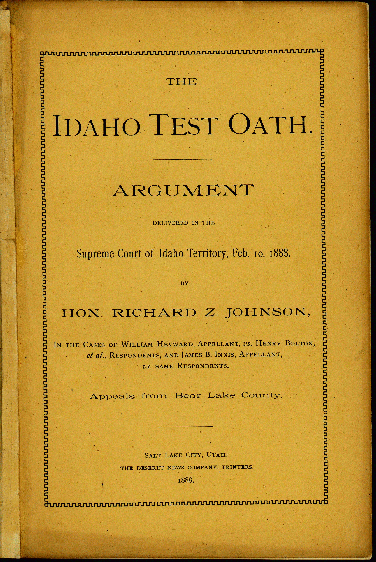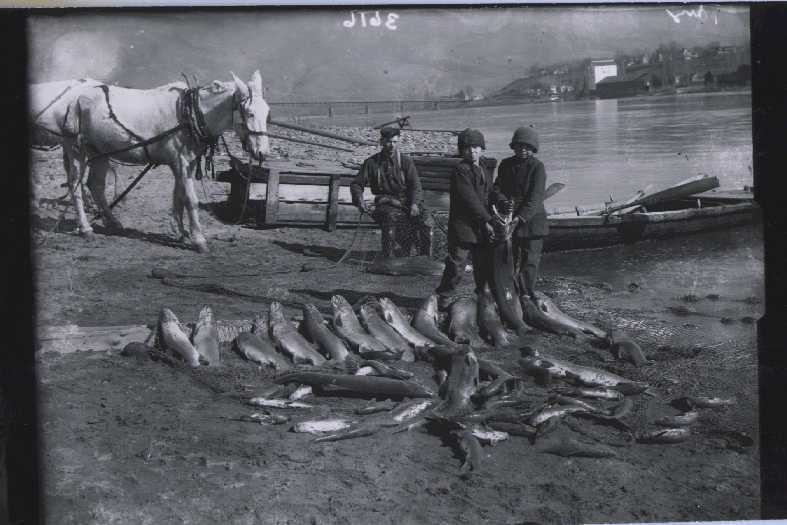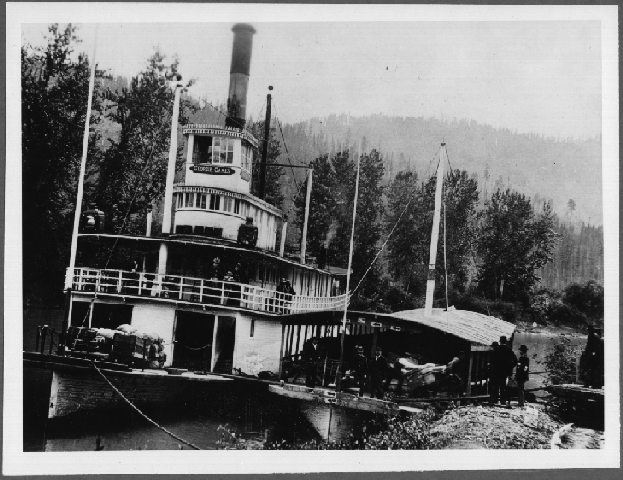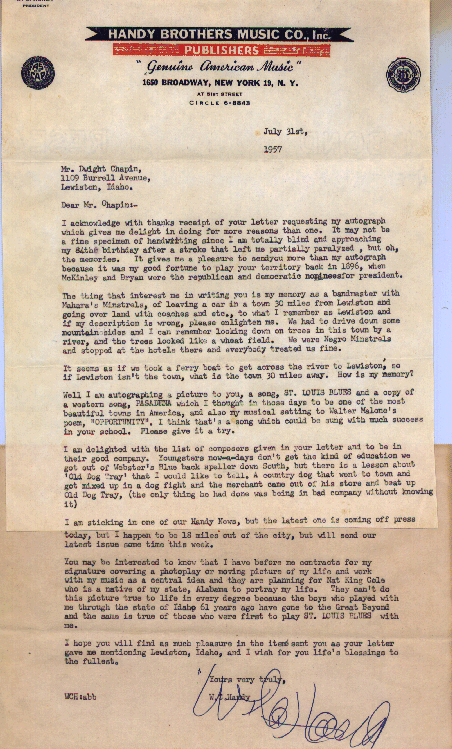


Special Collections at the University of Idaho Library offers a changing showcase of highlights from our collections. Here are the entries for 1996:
October 1996
Idaho politics during the territorial period were as convoluted and Byzantine as any before or since. Political and regional factionalism pitted the Democrats and the Mormons against the newly emerging Republicans and the Northern secessionists. When the Mormon and Democrat contingent lost control of the territory in 1882, ambitious Republicans sought to disenfranchise a quarter of the state's voters by passing an anti-Mormon test oath in 1884. Elected county officials were required to swear that they were neither polygamists nor believers nor members of any organization encouraging such practices. The intent was to completely disenfranchise members of the Church of Jesus Christ of Latter-day Saints and break their political power in southern Idaho.
When the Church rescinded its support for polygamy in preparation for Utah's admission as a state, a suit contesting the Idaho test oath was filed. Richard Z. Johnson, Yale Law graduate, Democrat, Attorney General of the territory, and soon a regent of the University of Idaho, claimed the legislation curtailed religious freedom by outlawing a belief. His speech opposing the oath before the Supreme Court of Idaho Territory in February 1888 was printed as a 45 page pamplet by the Deseret News of Salt Lake City. Johnson's review of cases and opinions and his rhetorical arguments for the principle all failed. The case ultimately was appealed to the United States Supreme Court where it was upheld even while the newly minted state constitution for Idaho imposed a similar anti-Mormon clause. Although the 1893 state legislature removed the restrictions against Mormon voters, the constitutional provision was not removed until 1982.
Acquisition of this item was made possible with funds provided by the Library Associates, the "friends" of the University of Idaho Library.
Cover: Johnson, Richard Z. Idaho Test Oath. Salt Lake City: Deseret News Company, 1888. Special Collections and Archives, University of Idaho Library.

August 1996
At the high end of summer, many seek the cooling pursuit of piscatorial pleasures. These youngsters, with their net full of steelhead, were captured on glass by John B. Wilson, a professional photographer in Lewiston, Idaho, between 1915 and 1920. In the background can be seen a river steamer at the grain storage building (possibly the Interior Warehouse Co.) just this side of the Lewiston-Clarkston bridge. The horse, an aid to pulling in the net, was also useful in getting home again.
Steelhead are a variety of rainbow trout which spawn in the Snake, Clearwater, and Salmon River drainages, migrate to the ocean as juveniles and return as adults several years later. Fishing for steelhead is different today; it is mostly catch-and-release in an effort to return to the pre-dam days of plentiful fish stocks. The National Marine Fisheries Service has recently proposed that Idaho steelhead be granted "threatened" status under the Endangered Species Act. The Idaho State Fish and Game Department manages this diminishing resource for Idahoans.
Natural resources issues such as these are documented in the Wilderness Archives at the University of Idaho Library. Papers, correspondence, photographs and other records are collected to provide an historical basis for today's decisions and programs. To participate in this effort, please contact:
Special Collections and Archives
University of Idaho Library
Moscow, ID 83844-2351
208-885-7951
Caption: Boys with catch on banks of the Snake River near Lewiston, Idaho, John B. Wilson, photographer, ca. 1915. #18-84, Historical Photograph Collection, Special Collections and Archives, University of Idaho Library.
July 1996
Henry Harmon Spalding, whose life as a missionary to the Nez Perce Indians was one of trial and tribulation, failed at most things in his life. However, his Idaho ministry had some significant accomplishments. Arriving at Lapwai Creek where it flows into the Clearwater River in 1836, Spalding recognized the need for the missionaries to learn the Nez Perce language in order to teach the gospel and, as well, civilization as they knew it. In 1839, using a printing press imported from Hawaii and a journeyman printer, he printed the first book in the Nez Perce language. It was also the first book printed in the Pacific Northwest. Knowing Spalding's career, it is not surprising that it was immediately discarded; the other missionaries disagreed with Spalding's choice of alphabet and made him adopt the standard form and redo the work.
The discovery of this first printing was not made until 1914 when a copy of the second book from the press, also from 1839, was closely examined. The printer had used the discarded sheets of the first printing to reinforce the binding of the second book, again entitled Nez Perces First Book: Designed for Children and New Beginners. The copy in the University of Idaho Library, from the collection of Thomas W. Streeter, lacks a binding and thus the binding reinforcement of the pages from the true first book. Enough fragments of the first First Book survived to make possible a 1994 reprint in celebration of the dedication of the new Idaho Center for the Book and the return of the original printing press to Idaho for a brief exhibition.
Spalding's missionary needs were not entirely solved by issuing the gospel and primers as published works. He also used the printer's skills to create small bound volumes of blank pages for the use of his students in the mission school. Two of those small books are among the holdings of the University of Idaho Library. One illustrates the binding reinforcement technique that doomed the first edition of Nez Perces First Book. The printed text used as stiffener refers to doctrinal questions typical of religious newspapers and periodicals of the day.
Collected and researched by Orofino's Carroll E. Brock, who donated them to the University of Idaho Library, they contain bible verses in the Nez Perce language. Although the writer has not been identified, and may not be the same throughout the two volumes, Spalding noted in 1842 that his wife spent much time with a pen "in printing." Such small books were, he said, distributed to his class of eleven "Chiefs." It was described as "a little book with a few verses of scripture printed with a pen, given to each of this class [which] did much to bring in this class, and the daily addition of a verse or two secures an increasing diligence."
Caption: Manuscript Bible verses in the Nez Perce language, ca. 1842. Special Collections and Archives, University of Idaho Library, MG 5144.

May 1996
It was in 1880 that the age of steamboat travel in the Coeur d'Alenes of northern Idaho began. For over a decade steamboats formed a valuable link between the gold and silver mining region and the rest of the world as it quickly became apparent that the key to the region's future hinged on the development of reliable transportation. The transition to hard-rock silver mining fueled the territory's development and required a complex transportation system necessary to maintain it.
The valuable silver ore would begin its journey on a narrow gauge railroad from the mines to the waterfront where it would be transferred into the deep hulls of the steamboats. Once loaded, the ore would be steamed the length of Lake Coeur d'Alene to the awaiting Northern Pacific Railroad cars in the city of Coeur d'Alene, Idaho. This lucrative trade, which could make a ship owner over $2,000 in a single trip, was short lived as the severe impact of the 1893 depression and an improved railroad system virtually ended the steamboats' ore hauling days on the lake.
This was not to be the end of these graceful boats. The rugged frontier country enticed new money from an unlikely source, tourism. During the 1890's the old ore carriers were quickly transformed into excursion boats offering luxurious trips on the "shadowy" St. Joe River and around scenic Lake Coeur d'Alene. The highly promoted trips promised the "tired and overworked" urban businessman and his family an invigorating cruise full of "clear vigorous mountain air, pure spring water, with a menu of trout, grouse, venison and wild fruits."
The Georgie Oakes, named for the daughter of Northern Pacific president Thomas F. Oakes, had the longest reign of the old river boats. Nicknamed the "Grande Dame," the Georgie Oakes was a popular excursion boat after her ore hauling days were over. She is pictured here at the old Cataldo Mission landing in a transitional stage, as both passengers and cargo share her deck. The smaller barge next to the Georgie Oakes is the hull of the old ore carrier Coeur d'Alene, whose cabins and superstructure were transferred to a larger hull in 1891 and named the Georgie Oakes. The barge is being used as a portable dock as the river bank is too shallow for direct unloading. Off to the far right the old narrow gauge railroad remains to transport people and materials to and from the remote silver mines.
Photograph selected, and text written, by photograph intern Stuart Robb.
Caption: Georgie Oakes (Steamboat), University of Idaho Library, Historic Photograph Collection, #6-96-7d.

January 1996
In this letter to a Lewiston autograph collector, W. C. Handy reminisces about traveling to Lewiston with Mahara's Minstrels. He pinpoints 1896 "when McKinley and Bryan were the republican and democratic nominees for president." Handy joined Mahara's in August 1896, according to his autobiography, Father of the Blues (1941), and the minstrel troupe reached Lewiston in early November. The Lewiston Twice-A-Week Tribune reported on October 31st that "Mahara's refined minstrels have made an engagement for Tuesday night next...."
Handy reports that the people of Lewiston treated him "fine." This was not the case in other Western towns visited by Mahara's Minstrels. In his autobiography, he reports fist-fights, getting shot at, and threatened with lynching. Life on the road was ordinarily hazardous, and not just from stale fruits and vegetables. Combining broad comedy, tender songs, and assorted hijinks, the minstrels would march noisily from the train to the theater (in Lewiston, as in other towns, called the opera house) to drum up an audience for the evening's performance.
Traveling minstrel shows were a common occurrence in Idaho mining towns from the earliest days. It was not until after the Civil War, however, that the performers of "negro melodies, laughable extravaganzas, burlesques, and musical gems and sweet ballads, together with their inimitable negro dances and short farces," as described in the Idaho World, September 7, 1867, were made up of African American troupers as well as Caucasians in black-face. Minstrel shows, black and white, became the foundation for many show-business careers in burlesque, vaudeville, theater, radio, movies, and television.
The movie of Handy's life, St. Louis Blues, was released in 1958 and, as promised, starred Nat King Cole as Handy. Also featured were Eartha Kitt, Pearl Bailey, Cab Calloway, Mahalia Jackson, Ruby Dee, and Ella Fitzgerald.
Acquisition of this autograph letter was made possible with funds provided by the Library Associates, the "friends" of the University of Idaho Library.
Letter: Handy, W. C. (William Christopher), 1873-1958. Letter, July 31, 1957, New York. Special Collections, University of Idaho Library. MG 5560
| [U of I Library] [Catalog Search] [U of Idaho] |
|
Special Collections & Archives University of Idaho Library PO Box 442351 Moscow, Idaho 83844-2351 USA (208) 885-7951 |
|
© Copyright 2002 University of Idaho Library |